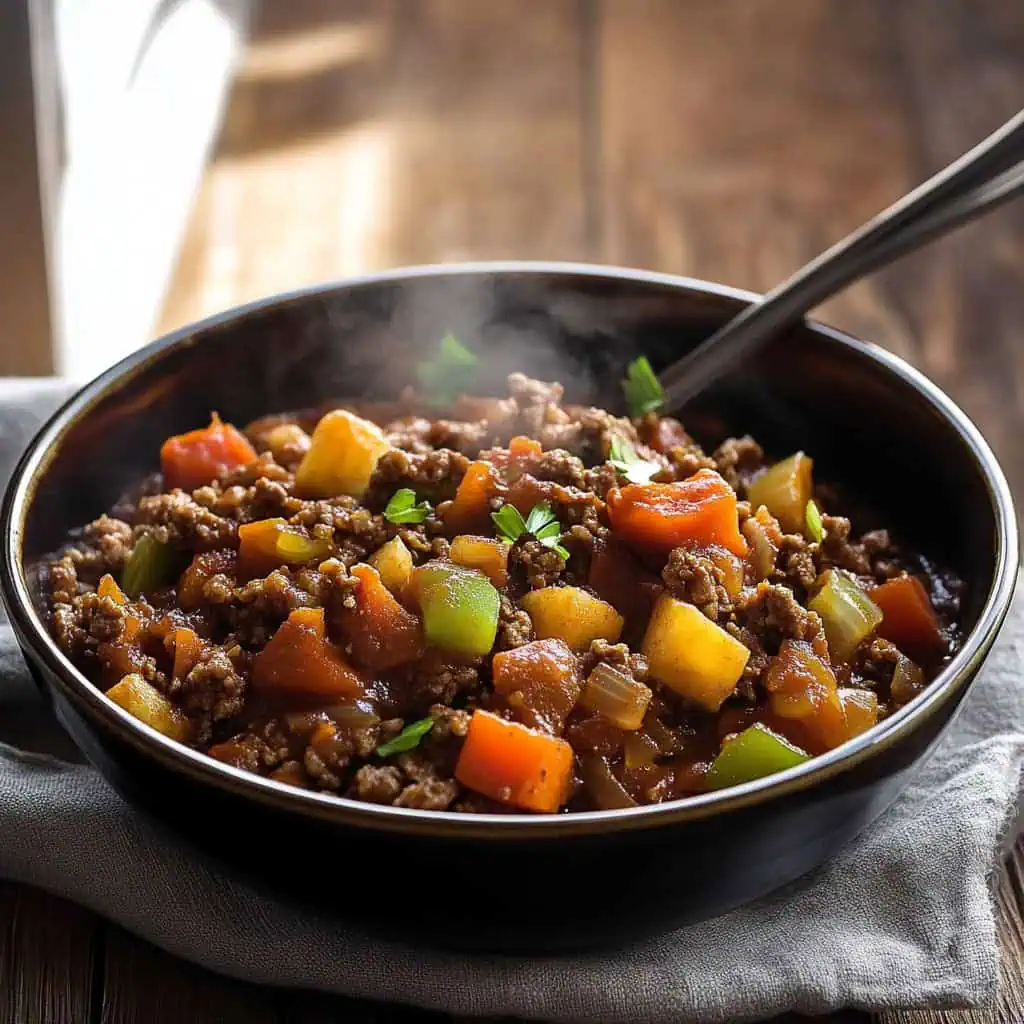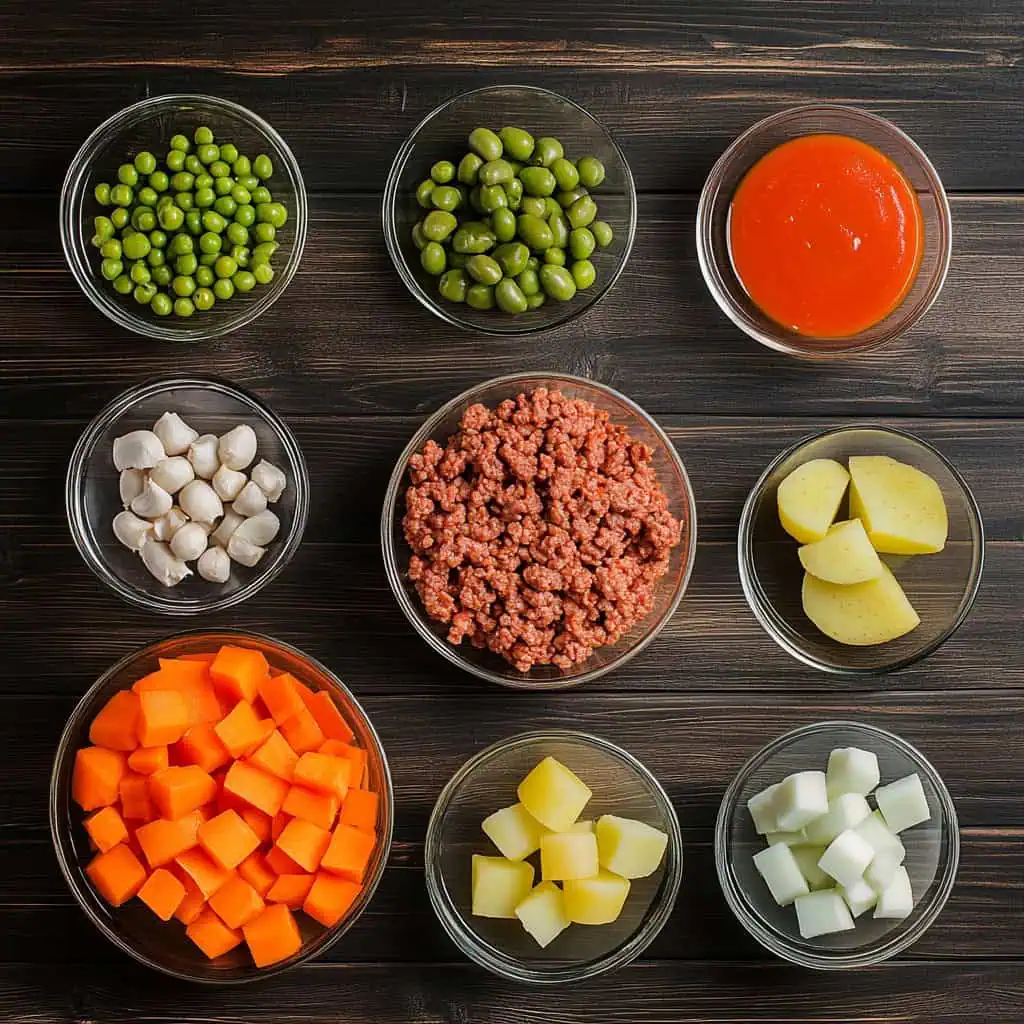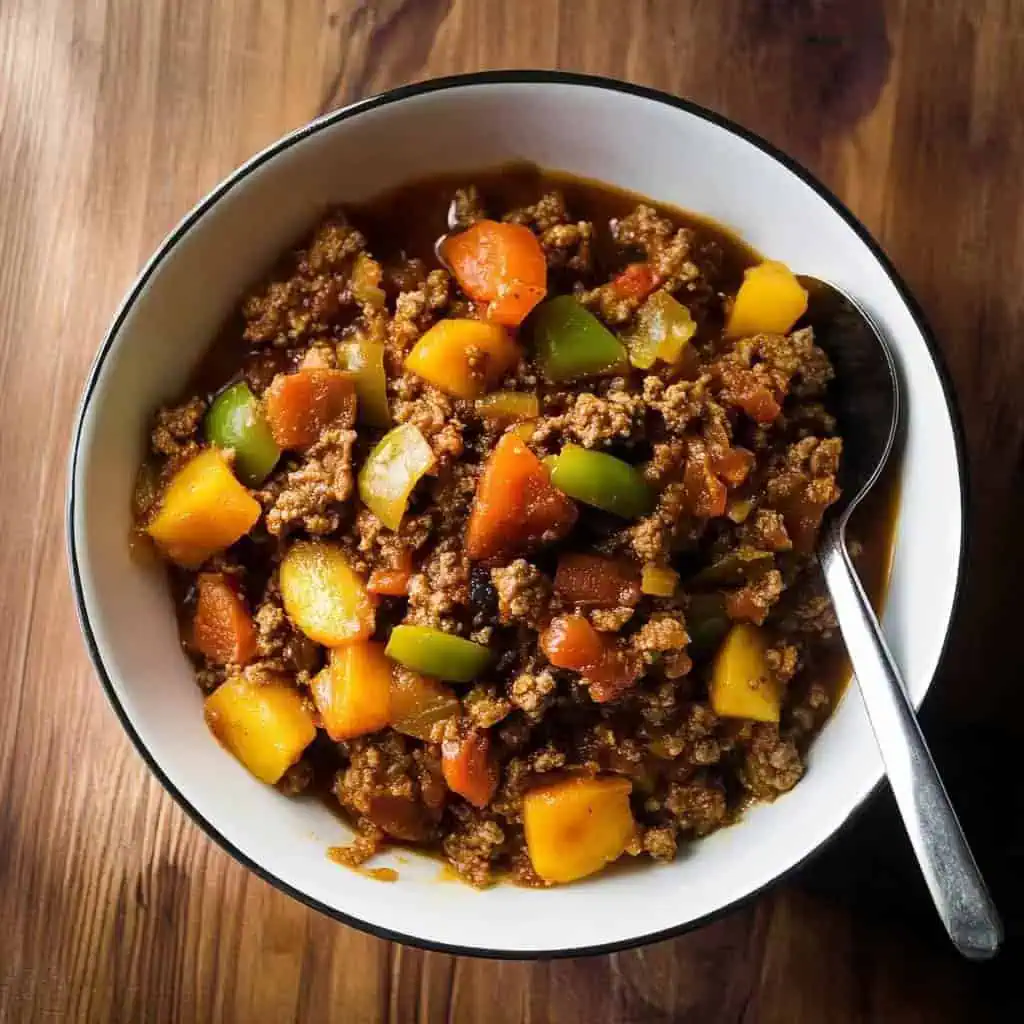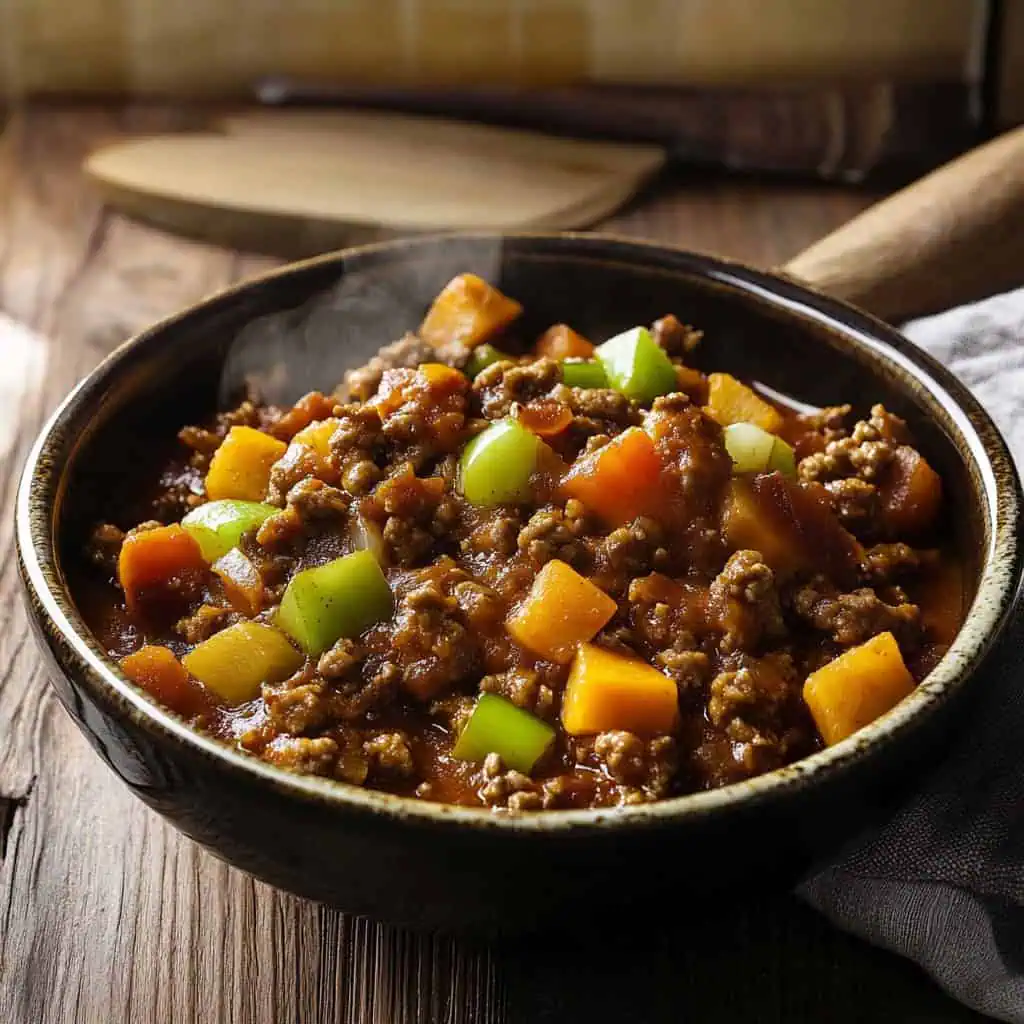Every time I catch a whiff of picadillo simmering on my stove, I'm instantly transported back to lazy Sunday afternoons in our old neighborhood in Pilar, Bataan.
Our next-door neighbor, Ate Josie, would always cook this comforting dish while I played patintero with her daughters in their garage. The aroma of garlic and tomatoes would smell through their screen windows, and without fail, she'd call us all in for merienda, serving steaming bowls of her picadillo with day-old pandesal for dipping into the savory broth.
Years later, with my own family now, I've recreated Ate Josie's recipe with two variations: the classic soup version perfect for rainy days, and a richer stew style that my kids love to pack for school lunch.
This budget-friendly, one-pan wonder has become my go-to recipe for busy weeknights, transforming simple ground beef and potatoes into a hearty meal that brings back those cherished childhood memories with every spoonful.
Jump to:

Why You'll Love This Recipe
- Two authentic versions in one recipe: Choose between comforting soup or hearty stew
- Budget-friendly ingredients you can find at any grocery store
- One-pan cooking means minimal cleanup
- Ready in just 30 minutes - perfect for busy weeknights
- Versatile recipe that's easy to customize with available ingredients
- Freezer-friendly for meal prep
- Kid-friendly comfort food
Ingredients
This Filipino Picadillo combines ground beef, potatoes, and tomatoes to create a flavorful, hearty dish that's both economical and satisfying. The beef provides rich protein and savory depth, while potatoes add substance and absorb the flavors of the broth.
Fresh garlic and onions create an aromatic base, with fish sauce adding that distinctive Filipino umami. The soup version keeps it light with fresh tomatoes and broth, perfect for comforting meals, while the stew version introduces sweet raisins and briny olives—Spanish influences that balance the savory elements. Carrots and peas add color, nutrition, and textural contrast.
Together, these ingredients represent the beautiful fusion of Spanish colonial influence and Filipino culinary adaptation, creating a versatile dish that stretches modest ingredients into a complete meal.

For Both Versions:
- 1 pound ground beef (80/20 lean-to-fat ratio recommended)
- 2 medium potatoes, peeled and cubed
- 1 onion, finely chopped
- 2 cloves garlic, minced
- 1 tablespoon fish sauce
- Salt and pepper to taste
- 1 tablespoon cooking oil
Additional for Soup Version (Pinadish):
- 3 large Roma tomatoes, chopped
- 2 cups beef broth or water
Additional for Stew Version (Ginisa):
- 1 cup tomato sauce
- ½ cup crushed tomatoes
- 2 medium carrots, diced
- ½ cup green peas
- 2 tablespoons raisins
- ¼ cup green olives, pitted
- ½ cup beef broth or water
Equipment
- Large deep skillet or Dutch oven - Provides even heat distribution for perfectly cooked meat and vegetables
- Sharp knife - Ensures uniform vegetable cuts for even cooking times
- Cutting board - Gives you a safe, stable surface for preparation
- Measuring cups and spoons - For accurate portioning of ingredients
- Wooden spoon - Helps break up meat while cooking without scratching your cookware
- Can opener - For opening canned tomatoes if using

How To Make
- Begin by heating oil in a large pan over medium heat. Add chopped onions and cook until they turn clear and soft. Stir in minced garlic and cook until fragrant.
- Add your ground beef to the pan. Break it apart into small pieces with your spoon while it cooks. Continue cooking until the meat turns brown and is no longer pink.
- Pour in the fish sauce and let it cook with the meat for 2 minutes.
- For soup version: Add your chopped fresh tomatoes and cook until they become soft.
- For stew version: Use tomato sauce and crushed tomatoes instead.
- Add your liquid - use 2 cups of broth or water for soup, or just ½ cup for stew. Let it come to a boil, then lower the heat to simmer. Add your cubed potatoes. For the stew version, also add your carrots and raisins.
- Cover your pan and cook everything for about 15 minutes, or until you can easily pierce the potatoes with a fork. For the stew version, this is when you add your green peas and olives - they only need about 3 minutes to cook.
- Taste your dish and add salt and pepper as needed. For stew, keep cooking until the sauce thickens - about 5 more minutes. For soup, you're ready to serve once the potatoes are tender.
- Let your picadillo rest for 5 minutes before serving. This helps all the flavors meld together. Serve hot over freshly cooked rice.

Tips from Lola's Kitchen
- Toast the garlic first for a nuttier, deeper flavor profile
- Marinate the beef in fish sauce for 10 minutes before cooking to enhance umami
- Cut all vegetables to the same size for even cooking
- Use lime zest to add a bright, citrusy note to your picadillo
- Add a bird's eye chili for heat if you prefer a spicy version
- Brown the meat thoroughly before adding other ingredients for better flavor
- Don't rush the simmering process - this develops depth of flavor
Traditional Serving Suggestions
- With steaming white rice
- As pandesal filling for a hearty sandwich
- Topped with a fried egg for a complete meal
- With a side of pickled papaya for contrast
- With calamansi or lime wedges on the side
Substitutions
- Ground beef → Ground pork or chicken (adjust cooking time accordingly)
- Fresh tomatoes → Canned diced tomatoes (drain excess liquid)
- Potatoes → Chayote or sweet potato for different texture and flavor
- Raisins → Chopped dates or cranberries for alternative sweetness
- Green olives → Black olives or capers for different briny flavor
- Fish sauce → Soy sauce (reduce added salt)
- Beef broth → Vegetable broth or chicken broth
Troubleshooting
Watery Sauce
- Problem: The stew version is too thin
- Solution: Simmer uncovered for 5-10 additional minutes to reduce
- Prevention: Start with less broth; you can always add more if needed
Tough Meat
- Problem: Ground beef is tough or rubbery
- Solution: Break meat into smaller pieces while cooking
- Prevention: Don't overcrowd the pan, which prevents proper browning
Unevenly Cooked Vegetables
- Problem: Some vegetables are overdone while others are undercooked
- Solution: Cut all vegetables to the same size
- Prevention: Add firmer vegetables (carrots) before softer ones (peas)
Bland Flavor
- Problem: Dish lacks depth of flavor
- Solution: Add an extra tablespoon of fish sauce or a bouillon cube
- Prevention: Adequately brown meat and ensure proper seasoning throughout cooking
Storage & Reheating
Refrigeration:
- Store in an airtight container
- Keeps 3-4 days in refrigerator
- Let cool completely before storing
Freezing:
- Freezes well for up to 2 months
- Use portion-sized containers for easier reheating
- Label with date and version (soup/stew)
- Leave some space at the top of containers for expansion
Reheating:
- Stovetop: Warm over low heat, adding water if needed to reach desired consistency
- Microwave: Heat for 2-3 minutes on medium power, stirring halfway through
- For soup version: You may need to add a splash of water when reheating

FAQ
Can I make this ahead?
Yes, picadillo actually tastes better the next day as the flavors have time to develop. It's perfect for meal prep.
Is this recipe freezer-friendly?
Absolutely. Both versions freeze well for up to 2 months. The stew version freezes particularly well.
What's the difference between picadillo and giniling?
Picadillo includes specific ingredients like raisins and olives showing Spanish influence, while giniling is a simpler Filipino ground meat dish.
Can I use ground pork instead of beef?
Yes, any ground meat works well. Adjust cooking times as ground pork may cook a bit faster than beef.
How do I make it healthier?
Use 90% lean ground beef, increase the vegetable-to-meat ratio, and reduce the oil. You can also substitute sweet potatoes for regular potatoes.
Can I make it spicy?
Yes, add chopped bird's eye chili or red pepper flakes to taste for a spicy version.
Is this gluten-free?
The base recipe is gluten-free, but check your broth and tomato sauce ingredients as some commercial brands may contain gluten.
How do I know when it's done?
The potatoes should be fork-tender, and in the stew version, the sauce should have thickened slightly.
Can I add other vegetables?
Absolutely! Bell peppers, corn, and green beans work well in either version.
What's the best beef-to-fat ratio for this dish?
An 80/20 lean-to-fat ratio gives the best flavor, but you can use leaner beef if preferred.
Related
Looking for other recipes like this? Try these:

Filipino Picadillo (With Soup and Stew Versions)
Equipment
- Large deep skillet or Dutch oven (Kawali o Kaldero) for even heat distribution
- Sharp knife (kutsilyo) for uniform vegetable cuts
- Cutting board (Sangkalan) for preparation
- Measuring cups and spoons (Panukat) for accurate portions
- Wooden spoon (sandok na kahoy) for breaking up meat without scratching pan
- Can opener (if using canned tomatoes)
Ingredients
For Both Versions:
- 1 pound ground beef Giniling na baka - 80/20 lean-to-fat ratio recommended
- 2 medium potatoes Patatas, peeled and cubed
- 1 onion Sibuyas, finely chopped
- 2 cloves garlic Bawang, minced
- 1 tablespoon fish sauce Patis
- Salt Asin and pepper (Paminta) to taste
- 1 tablespoon cooking oil Mantika
Additional for Soup Version (Pinadish):
- 3 large Roma tomatoes Kamatis, chopped
- 2 cups beef broth or water Sabaw
Additional for Stew Version (Ginisa):
- 1 cup tomato sauce Sarsa ng kamatis
- ½ cup crushed tomatoes
- 2 medium carrots Karot, diced
- ½ cup green peas Gisantes
- 2 tablespoons raisins Pasas
- ¼ cup green olives Aseytunas, pitted
- ½ cup beef broth or water
Instructions
- Begin by heating oil in a large pan over medium heat. Add chopped onions and cook until they turn clear and soft. Stir in minced garlic and cook until you can smell its aroma.
- Add your ground beef to the pan. Break it apart into small pieces with your spoon while it cooks. Keep cooking until the meat turns brown and is no longer pink.
- Pour in the fish sauce and let it cook with the meat for 2 minutes. Now, if you're making soup, add your chopped fresh tomatoes and cook until they become soft. For stew, use tomato sauce and crushed tomatoes instead.
- Add your liquid - use 2 cups of broth or water for soup, or just ½ cup for stew. Let it come to a boil, then lower the heat to simmer. Add your cubed potatoes now. If you're making stew, also add your carrots and raisins.
- Cover your pan and cook everything for about 15 minutes, or until you can easily pierce the potatoes with a fork. For the stew version, this is when you add your green peas and olives - they only need about 3 minutes to cook.
- Taste your dish and add salt and pepper as needed. If you're making stew, keep cooking until the sauce thickens up - about 5 more minutes. For soup, you're ready to serve once the potatoes are tender.
- Let your picadillo rest for 5 minutes before serving. This helps all the flavors come together. Serve hot over freshly cooked rice. If you like, you can add some chopped green onions on top or serve with calamansi on the side.
- Remember: The meat and potatoes should be tender, and the stew version should have a thick, rich sauce while the soup version should be brothy. Enjoy your homemade picadillo.
Tips from Lola's Kitchen
- Use dayap (local lime) zest for extra Filipino flavor
- Add siling labuyo (bird's eye chili) for heat
- Marinate beef in patis for 10 minutes before cooking
- Cut vegetables in same size for even cooking
- Toast garlic first for nuttier flavor
Nutrition
The Story Behind Filipino Picadillo
Growing up in Philippine kitchens, picadillo stands as a testament to our country's rich culinary heritage, particularly the profound influence of Spanish colonization that spanned more than three centuries. The dish's name originates from the Spanish word "picar," meaning "to mince" or "to chop," reflecting the preparation method of its main ingredient - ground beef.
While Spanish picadillo typically features a mix of ground meat with olives, raisins, and capers in a rich tomato base, Filipino cooks adapted this Mediterranean classic to suit local tastes and ingredients. This adaptation birthed two distinct versions that showcase Filipino ingenuity: the comforting soup variety (pinadish) that became a rainy day favorite, and the hearty stew version (ginisa) that's often packed in school lunchboxes across the country.
What makes Filipino picadillo uniquely ours is the addition of patis (fish sauce) instead of salt, creating that distinct umami flavor that's characteristic of Filipino cuisine. The dish also highlights our love for turning modest ingredients into filling family meals - a practice born from generations of Filipino mothers making the most of what's available in their pantries. Whether served as a soup or stew, picadillo embodies the Filipino tradition of "lutong bahay" (home cooking), where simple ingredients transform into dishes that bring families together at the dinner table.
Today, picadillo remains a beloved comfort food that bridges generations, with each family adding their own twist to the basic recipe. Some households swear by adding sayote instead of potatoes, while others mix in chopped hotdogs or turn leftovers into torta (omelet). This adaptability and resourcefulness perfectly capture the essence of Filipino cooking - practical yet flavorful, simple yet satisfying.
In modern Filipino kitchens, picadillo continues to evolve while maintaining its status as a reliable weeknight dinner option. Its versatility makes it a favorite among busy parents and young professionals looking to recreate the flavors of their childhood. Whether you're craving the soul-warming soup version on a rainy day or the rich, meat-and-potato stew that reminds you of mom's cooking, Filipino picadillo proves that the best dishes are often the ones that tell our story of cultural adaptation and culinary creativity.










Comments
No Comments